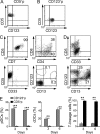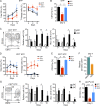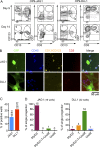Spatially restricted JAG1-Notch signaling in human thymus provides suitable DC developmental niches
- PMID: 28947612
- PMCID: PMC5679173
- DOI: 10.1084/jem.20161564
Spatially restricted JAG1-Notch signaling in human thymus provides suitable DC developmental niches
Abstract
A key unsolved question regarding the developmental origin of conventional and plasmacytoid dendritic cells (cDCs and pDCs, respectively) resident in the steady-state thymus is whether early thymic progenitors (ETPs) could escape T cell fate constraints imposed normally by a Notch-inductive microenvironment and undergo DC development. By modeling DC generation in bulk and clonal cultures, we show here that Jagged1 (JAG1)-mediated Notch signaling allows human ETPs to undertake a myeloid transcriptional program, resulting in GATA2-dependent generation of CD34+ CD123+ progenitors with restricted pDC, cDC, and monocyte potential, whereas Delta-like1 signaling down-regulates GATA2 and impairs myeloid development. Progressive commitment to the DC lineage also occurs intrathymically, as myeloid-primed CD123+ monocyte/DC and common DC progenitors, equivalent to those previously identified in the bone marrow, are resident in the normal human thymus. The identification of a discrete JAG1+ thymic medullary niche enriched for DC-lineage cells expressing Notch receptors further validates the human thymus as a DC-poietic organ, which provides selective microenvironments permissive for DC development.
© 2017 Martín-Gayo et al.
Figures










Similar articles
-
Direct comparison of Dll1- and Dll4-mediated Notch activation levels shows differential lymphomyeloid lineage commitment outcomes.J Immunol. 2010 Jul 15;185(2):867-76. doi: 10.4049/jimmunol.1000782. Epub 2010 Jun 14. J Immunol. 2010. PMID: 20548034
-
Bone marrow-derived hemopoietic precursors commit to the T cell lineage only after arrival in the thymic microenvironment.J Immunol. 2007 Jan 15;178(2):858-68. doi: 10.4049/jimmunol.178.2.858. J Immunol. 2007. PMID: 17202347
-
Expression of JAGGED1 in T-lymphocytes results in thymic involution by inducing apoptosis of thymic stromal epithelial cells.Genes Immun. 2006 Sep;7(6):476-86. doi: 10.1038/sj.gene.6364318. Epub 2006 Jun 22. Genes Immun. 2006. PMID: 16791277
-
Regulation of intrathymic T-cell development by Lunatic Fringe- Notch1 interactions.Immunol Rev. 2006 Feb;209:76-94. doi: 10.1111/j.0105-2896.2006.00360.x. Immunol Rev. 2006. PMID: 16448535 Review.
-
Differential requirements for Wnt and Notch signaling in hematopoietic versus thymic niches.Ann N Y Acad Sci. 2012 Aug;1266:78-93. doi: 10.1111/j.1749-6632.2012.06626.x. Ann N Y Acad Sci. 2012. PMID: 22901260 Review.
Cited by
-
Quantification of dendritic cell subsets in human thymus tissues of various ages.Immun Ageing. 2021 Nov 18;18(1):44. doi: 10.1186/s12979-021-00255-8. Immun Ageing. 2021. PMID: 34794472 Free PMC article.
-
Intrathymic dendritic cell-biased precursors promote human T cell lineage specification through IRF8-driven transmembrane TNF.Nat Immunol. 2023 Mar;24(3):474-486. doi: 10.1038/s41590-022-01417-6. Epub 2023 Jan 26. Nat Immunol. 2023. PMID: 36703005
-
Fratricide-resistant CD1a-specific CAR T cells for the treatment of cortical T-cell acute lymphoblastic leukemia.Blood. 2019 May 23;133(21):2291-2304. doi: 10.1182/blood-2018-10-882944. Epub 2019 Feb 22. Blood. 2019. PMID: 30796021 Free PMC article.
-
Large-Scale Human Dendritic Cell Differentiation Revealing Notch-Dependent Lineage Bifurcation and Heterogeneity.Cell Rep. 2018 Aug 14;24(7):1902-1915.e6. doi: 10.1016/j.celrep.2018.07.033. Cell Rep. 2018. PMID: 30110645 Free PMC article.
-
The thymus road to a T cell: migration, selection, and atrophy.Front Immunol. 2024 Aug 27;15:1443910. doi: 10.3389/fimmu.2024.1443910. eCollection 2024. Front Immunol. 2024. PMID: 39257583 Free PMC article. Review.
References
-
- Bendriss-Vermare N., Barthélémy C., Durand I., Bruand C., Dezutter-Dambuyant C., Moulian N., Berrih-Aknin S., Caux C., Trinchieri G., and Brière F.. 2001. Human thymus contains IFN-alpha-producing CD11c(-), myeloid CD11c(+), and mature interdigitating dendritic cells. J. Clin. Invest. 107:835–844. 10.1172/JCI11734 - DOI - PMC - PubMed
MeSH terms
Substances
LinkOut - more resources
Full Text Sources
Other Literature Sources
Medical

